Tender and moist gluten-free coconut cake made with unsweetened shredded coconut. A grain-free coconut flour cake that is ultra fluffy and bursting with coconut flavor. Versatile as a 2-layer, 3-layer, or sheet cake, using whatever pans you have on hand!

This post is sponsored by Andronico's Community Markets, a long-term partner of Snixy Kitchen, but the opinions are all my own.
Jump to:
- Why you'll love this gluten-free coconut cake
- Andronico's: Ingredients for Gluten-Free Coconut Cake
- Grain-Free Coconut Flour Cake
- Unsweetened or Sweetened Shredded Coconut
- How to Make Gluten-Free Gluten-Free Coconut Cake
- Coconut Cream Cheese Frosting
- Can you Make Dairy-Free Gluten-Free Coconut Cake?
- How to Store Gluten-Free Coconut Cake
- Can you Freeze Gluten-Free Coconut Cake?
- More Gluten-Free Layer Cakes
- Recipe
- Comments
If you're over there thinking, "Pass, I hate coconut," just stay with me for a moment. I used to be one of you. This cake is filled with unsweetened shredded coconut that has all of the coconut flavor with none of the cloyingly sweet stringy texture that gets stuck in your teeth.
Three layers of tender and fluffy coconut-flavored cake slathered with coconut cream cheese frosting, enrobed in a cloak of unsweetened shredded coconut. The texture is tender and moist, leaving out the most common reasons people hate coconut.
For those extreme coconut-skeptics, try toasting the coconut before pressing it onto the cake for a crunchier texture and more nutty flavor.

Why you'll love this gluten-free coconut cake
- The cake bakes up with a super soft and fluffy crumb.
- It's also very moist and tender. Coconut flour tends to bake up very dry, but this coconut flour cake is very moist thanks to tapioca flour and cassava flour, along with plenty of oil and butter.
- The cake has a robust coconut flavor from coconut flour, coconut oil, shredded coconut, coconut milk, and just a hint of coconut extract
- The recipe is flexible, depending on your pans. It can be baked in many different sizes of cake pans, only needing to adjust the bake time, as written. It can also be baked as a 2-layer or 3-layer cake, depending on how many pans you have. It can even be baked as cupcakes!
- Coconut is so versatile, so you can dress this cake up with your favorite fillings and/or toppings. Try toasted coconut on the outside, fill the layers with strawberry jam, or decorate with Cadbury mini eggs for easter!

Andronico's: Ingredients for Gluten-Free Coconut Cake
If you're in the Bay Area, you can pick up everything for this gluten-free coconut cake from your local Andronico's Community Market. From coconut flour to unsweetened shredded coconut to cream cheese - they carry it all. Like my gluten-free sugar cookie bars, I also picked up some seasonal decorations for on top. In this case, Cadbury mini eggs give the cake an Easter twist.

Here's what you need for the gluten-free coconut flour cake:
- Bob's Red Mill tapioca starch/flour
- Bob's Red Mill coconut flour
- Bob's Red Mill cassava flour
- Baking soda, baking powder, and salt
- Egg whites
- Cream of tartar: to help stabilize the egg whites
- Unsalted butter
- Coconut oil
- Granulated sugar
- Vanilla and coconut extracts
- Full-fat canned coconut milk
- Unsweetened shredded coconut
Here's what you need for the coconut cream cheese frosting:
- Unsalted butter
- Full-fat cream cheese brick
- Powdered sugar
- Full-fat canned coconut milk
- Vanilla and coconut extracts
- Salt
Grain-Free Coconut Flour Cake
Not only is this coconut flour cake gluten-free, it's also entirely grain-free. A combination of coconut flour, cassava flour, and tapioca flour keeps the cake tender, moist, and flavorful, without any grains.
Unsweetened or Sweetened Shredded Coconut
While most coconut cakes call for sweetened shredded coconut, I find the texture of sweetened shredded coconut to be stringy and chewy in all the wrong ways.
The texture of unsweetened shredded coconut is fine and crisp, and when baked in a cake, seems to melt when you eat it. It also creates a less cloyingly sweet frosting topping with more coconut flavor. Because I'm using unsweetened coconut in the batter too, I've added a bit more sugar to the recipe to ensure the cake stays moist and flavorful.
How to Make Gluten-Free Gluten-Free Coconut Cake
Sift together the dry ingredients. Set aside.

Whip the egg whites with cream of tartar until soft peaks form. Set aside.

Cream the butter, coconut oil, and granulated sugar until light and fluffy. Mix in the vanilla and coconut extracts until combined.

With the mixer on low, alternate adding the coconut milk and the flours in 2 parts each, scraping down the sides as needed, and mixing until well combined.

Mix in the shredded coconut until well combined.
Fold in ⅓ of the whipped egg whites to loosen the batter.

Then carefully fold in the remaining whipped egg whites until just combined.

Divide the batter evenly between your prepared cake pans and bake, according to your pan size in the instructions below. Depending on your preference, you can bake this as either a 2-layer or 3-layer. The cake should just spring back when gently touched, and the edges just barely golden brown.

Let cool in the pan for 10 minutes then transfer to a wire rack to cool completely before frosting.

Cream the butter over medium speed, then mix in the cream cheese pieces one at a time, scraping down the sides. Slowly mix in the powdered sugar, followed by the coconut milk, vanilla and coconut extracts, and salt and mix until smooth.
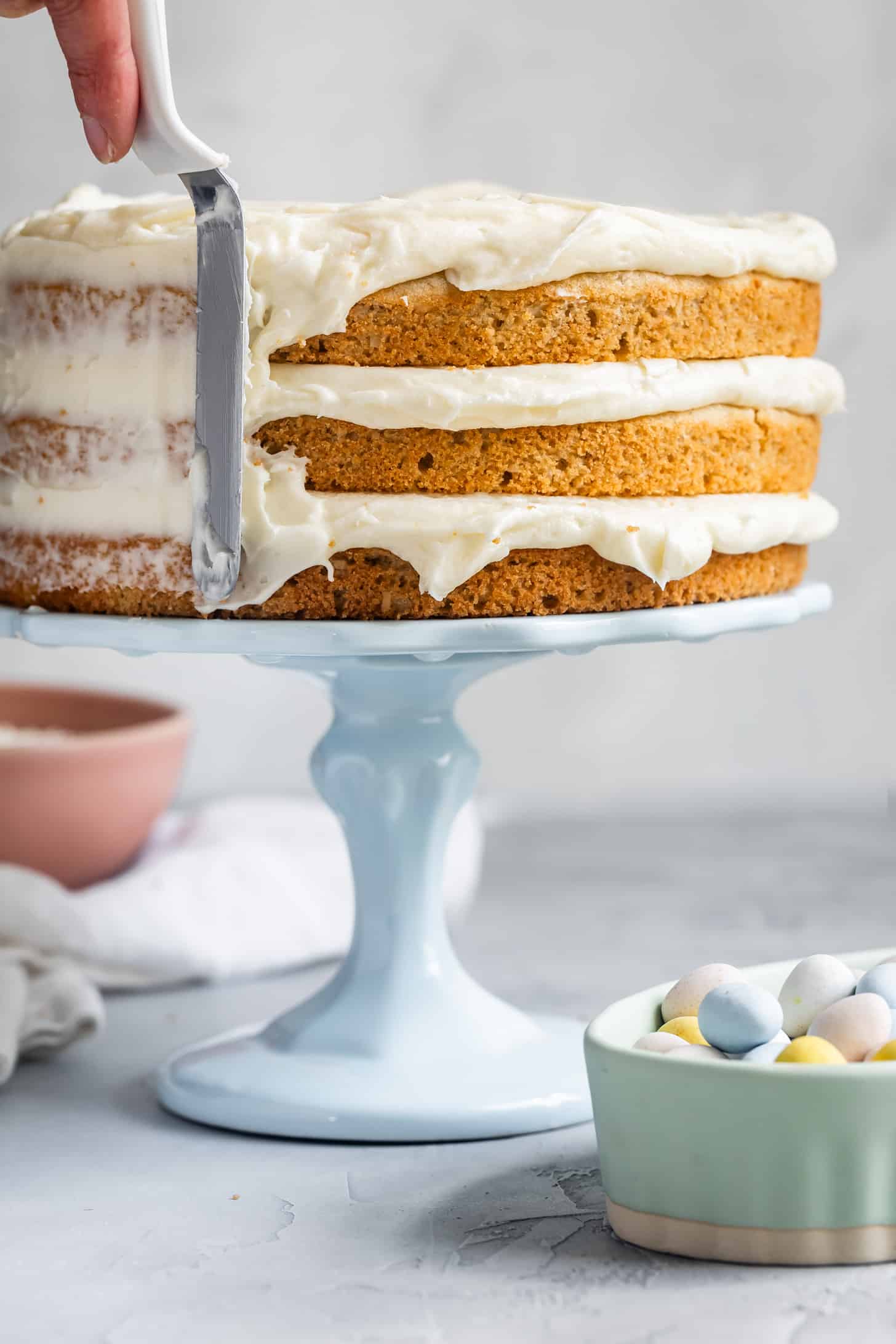
Layer the cake with ½ cup frosting between each layer. Create a crumb coat - spread a very thin layer of frosting on the sides and top and chill for 15 minutes.

Spread the remaining frosting over the cake, then gently press the unsweetened shredded coconut all over the sides and top of your cake.
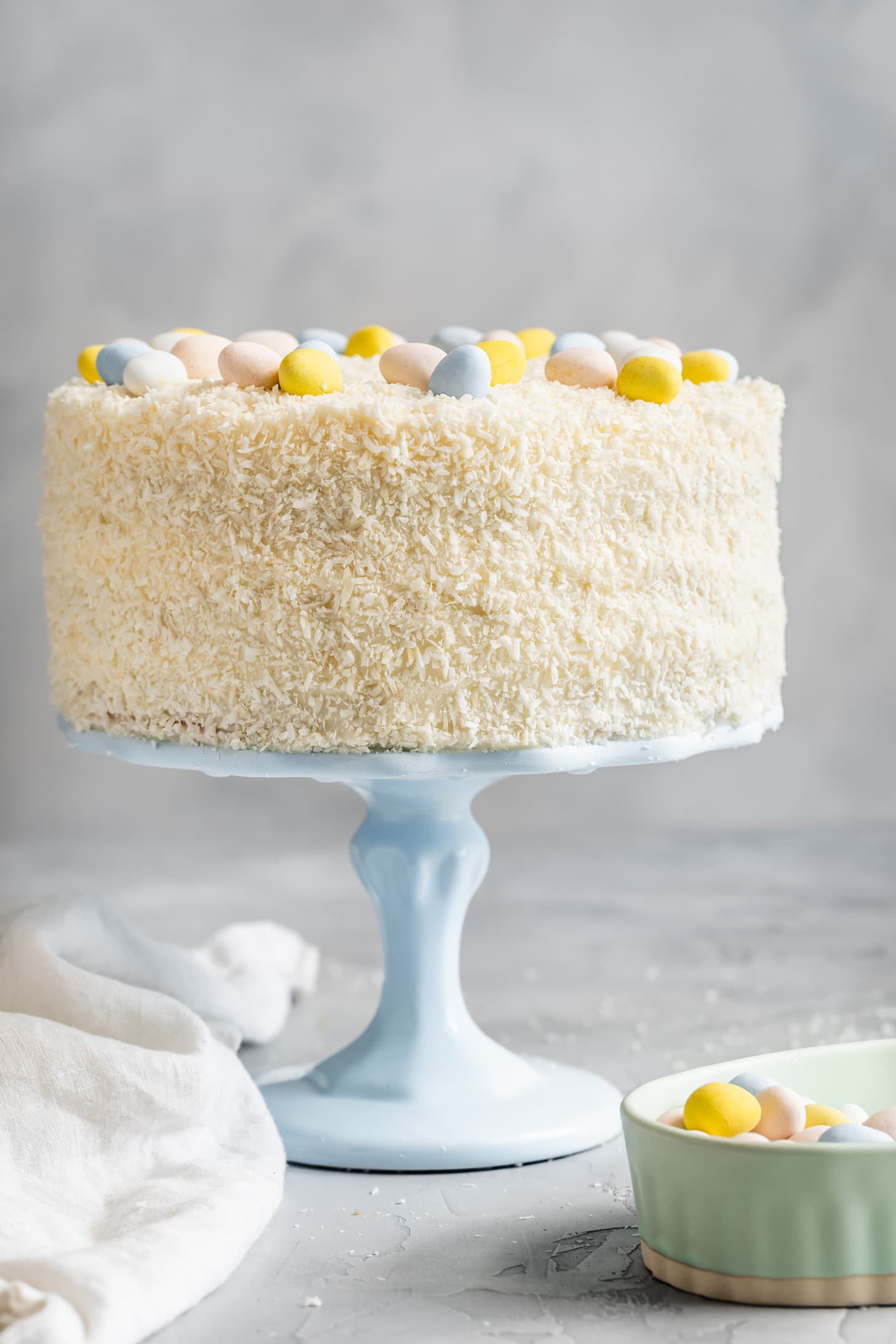
Coconut Cream Cheese Frosting
A smooth and tangy cream cheese frosting pairs beautifully with gluten-free coconut cake. For this tender coconut layer cake, I'm using a higher ratio of butter to cream cheese, which makes the frosting thicker and more stable for slicing.
Adding a hint of coconut milk and coconut extract creates a coconut-forward lusciously smooth frosting that will have you licking your plate.

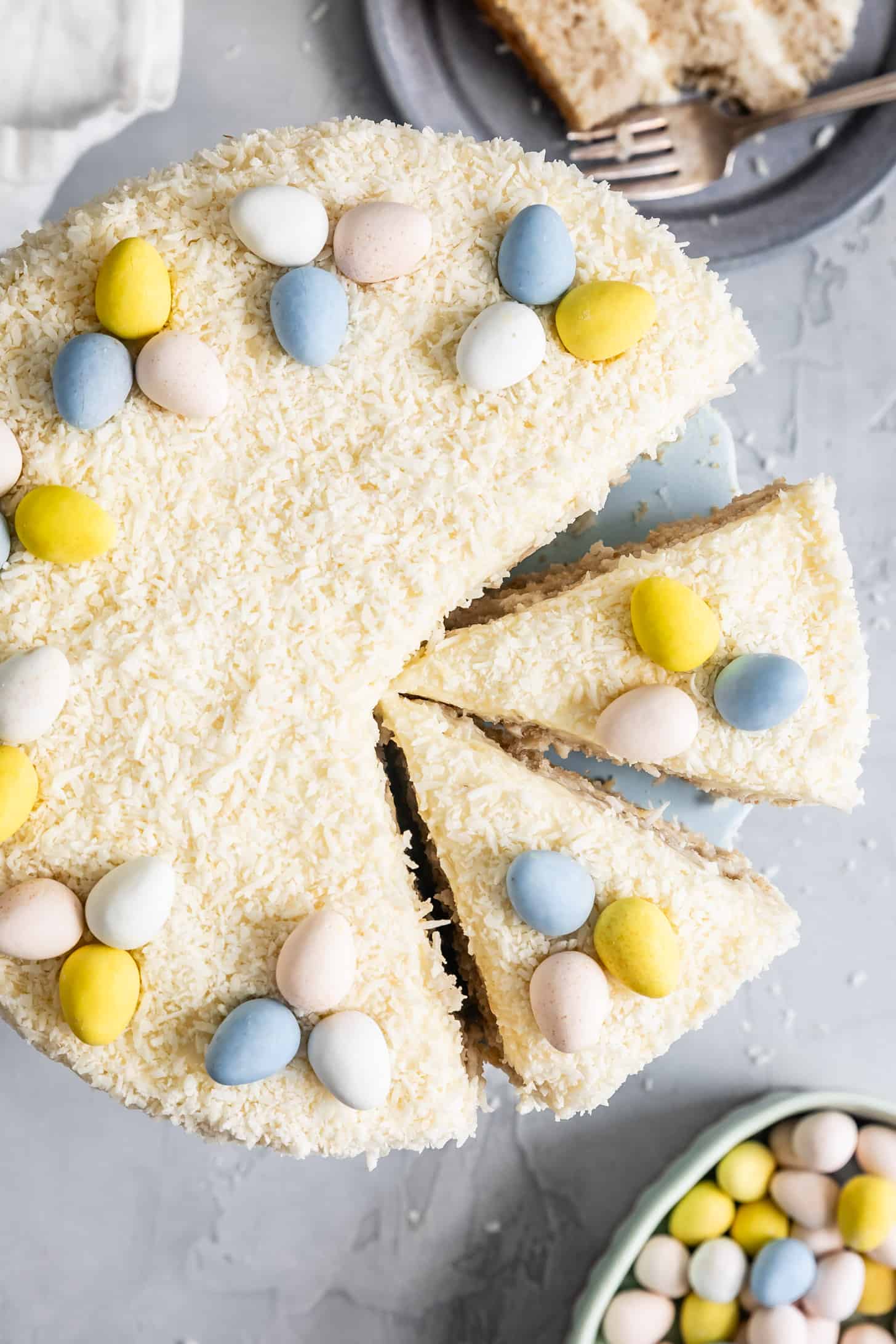
Can you Make Dairy-Free Gluten-Free Coconut Cake?
To make gluten-free and dairy-free coconut cake, replace the unsalted butter with stick plant butter in the cake.
To make the frosting dairy-free, use stick plant butter and plant-based cream cheese. Alternatively, you can substitute the cream cheese by weight with additional plant butter to make a dairy-free buttercream frosting.
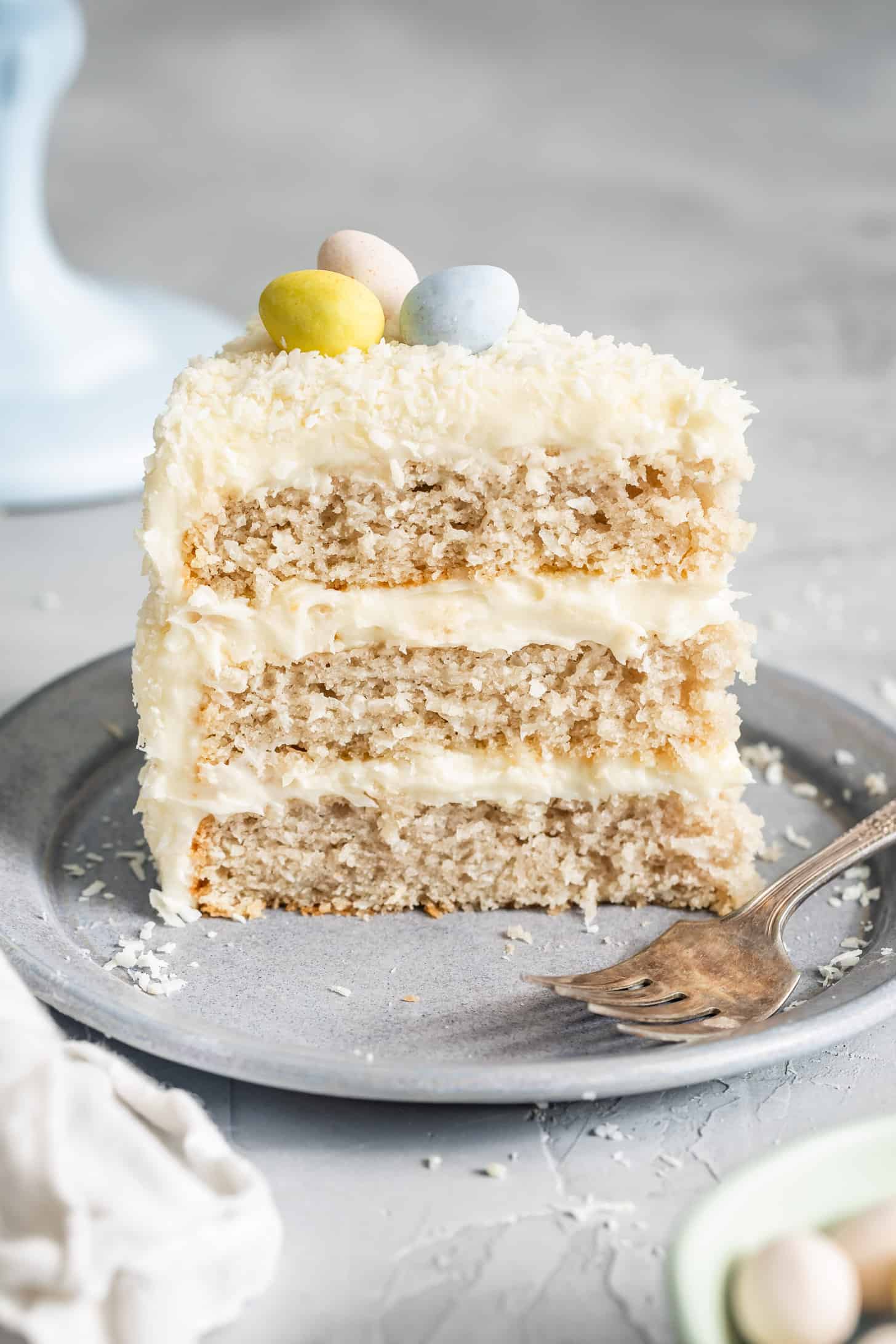
How to Store Gluten-Free Coconut Cake
Store any cake leftovers in an air-tight container at room temperature for up to 2 days. Because this is a butter-based cake, the texture is best when served at room temperature. it's susceptible to drying out if left uncovered or stored in the refrigerator.
You can also store the cake for longer periods in the freezer! See below
Can you Freeze Gluten-Free Coconut Cake?
FREEZING UNFROSTED
You can bake and cool the gluten-free coconut cake layers in advance and freeze them until you're ready to frost the cake. Before freezing, wrap each cooled layer tightly in plastic wrap. Plastic wrap is sufficient for just a few days, but for longer storage, place the wrapped layers in freezer bags to avoid freezer burn.
When ready to frost the cake, set the frozen layers on a cooling rack at room temperature for about an hour to defrost before frosting the cake as normal.
FREEZING FROSTED
You can also freeze the gluten-free coconut cake once it's frosted. If you have space in your freezer, you can freeze the cake whole. To do so, place the whole cake in the freezer for an hour until the outside is firm, before wrapping it well in plastic wrap. Store it like this for up to 4 days. To defrost, leave the frozen cake at room temperature for 3 hours before slicing and serving.
You can also store leftover slices in an airtight container in the freezer for up to 2 months. let sit at room temperature for 30 minutes before eating.


Recipe
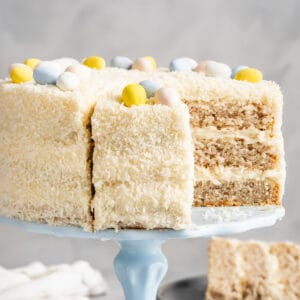
Gluten-Free Coconut Cake
Ingredients
- 133 g (1 cup + 3 tablespoons) Bob’s Red Mill tapioca flour
- 104 g (1 cup + 1 tablespoon) Bob's Red Mill coconut flour
- 54 g (¼ cup + 2 tablespoons) Bob's Red Mill cassava flour
- 1 tablespoon baking powder
- ½ teaspoon baking soda
- 1 teaspoon kosher salt
- 5 large egg whites, room temperature
- ½ teaspoon cream of tartar
- ½ cup (1 stick) unsalted butter
- 42 g (3 tablespoons) coconut oil, room temperature. I recommend unrefined as it will add more coconut flavor, but refined works too
- 375 g (1¾ cups + 2 tablespoons) granulated sugar
- 1½ teaspoons pure vanilla extract
- 1 teaspoon coconut extract
- 300 g (1¼ cups) full-fat canned coconut milk, room temperature and well-mixed
- 85 g (1 cup) unsweetened shredded coconut
- 1 cup (2 sticks) unsalted butter, room temperature
- 8 ounces (226 g) full-fat cream cheese (blocked), room temperature
- 540 g (4½ cups) powdered sugar, sifted
- 1 tablespoon full-fat canned coconut milk
- ½ teaspoon pure vanilla extract
- 1 teaspoon coconut extract
- ¼ teaspoon kosher salt
- 85 g (1 cup) unsweetened shredded coconut, for sprinkling
INSTRUCTIONS
Gluten-Free Coconut Flour Cake
- Preheat the oven to 350°F. Lightly grease and line the bottom of three 8-inch cake pans with parchment paper. See note about using different sizes of cake pans or baking just two layers.
- In a medium bowl, sift together coconut flour, tapioca flour, cassava flour, baking powder, baking soda, and salt. Set aside.
- Using a hand mixer or whisk, beat the egg whites and cream of tartar in a medium bowl, starting on low speed and increasing to high speed until soft peaks form. When the beater is pulled out a peak should rise and the very tip should fall. Set aside.
- In the bowl of a stand mixer fitted with the paddle attachment, or in a large mixing bowl with a hand mixer, cream the butter, coconut oil, and granulated sugar until light and fluffy, scraping down the sides as needed, 3-4 minutes.
- Mix in the vanilla and coconut extracts until combined.
- With the mixer on low speed, alternate adding the coconut milk and the flours in 2 parts each, scraping down the sides as needed, and mixing until well combined.
- Mix in the shredded coconut until well combined.
- Using a silicone spatula, fold in ⅓ of the whipped egg whites to loosen the batter. Then carefully fold in the remaining whipped egg whites until just combined.
- Divide the batter evenly between your prepared cake pans, smoothing out the top. Bake for 24-26 minutes for an 8-inch 3-layer cake. See note about bake times for different sizes of pans or for baking a 2-layer cake. A toothpick inserted into the center should come out clean, the center should just spring back when gently touched, and the edges just barely golden brown.
- Remove from oven and let cool in the pan for 10 minutes, then overturn the cake onto a wire rack to cool completely. To do this, I place a large wire rack or sheet pan over the baking pan and, holding it together, carefully flip the cake to release. Peel off the parchment paper, then place a wire rack over the top, and carefully flip it right side up.
Coconut Cream Cheese Frosting
- Once cool, make the cream cheese frosting. In the bowl of a stand mixer fitted with the paddle attachment, cream the butter over medium speed. With the mixer on low, add the cream cheese pieces one at a time. Scrape down the sides and mix until well combined. With the mixer on low, slowly add the powdered sugar, beating until incorporated. Add the coconut milk, vanilla and coconut extracts and salt and mix until smooth.
- Frost the cake. Spread ½ cup of frosting between each layer. spread a very thin layer of frosting on the top and side. Use a bench scraper or offset spatula to smooth and scrape the frosting off the sides. This is the crumb coat to keep the crumbs off your final pretty frosting layer. Chill the cake for 15 minutes. Spread remaining frosting over the cake, smoothing it using an offset spatula. Using the palm of your hand, gently press the unsweetened shredded coconut all over the sides and top of your cake. Slice and serve.
Notes
Using Different Cake Pans
- 2-layer 8-inch cake: This cake also works when baked as two thicker layers rather than three. For just two 8-inch layers, extend the bake time by 8-10 minutes (32-36 minutes total), until the center springs back when gently touched.
- 2-layer 9-inch cake: If you only have 9-inch cake pans, you can make a 2-layer cake (3 layers would be too thin). Increase the bake time by 2-3 minutes (26-29 minutes total), until the center springs back when gently touched.
- 9x13 sheet cake pan: You can bake this in a metal 9x13 cake pan. Extend the bake time by 3-4 minutes (27-30 minutes total), until the center springs back when gently touched.


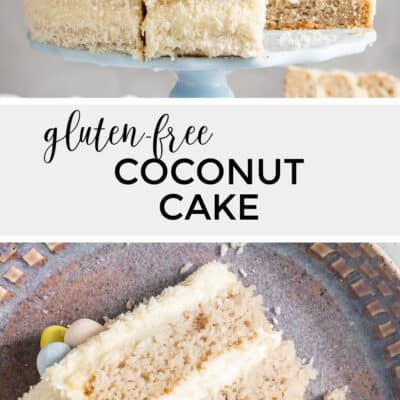





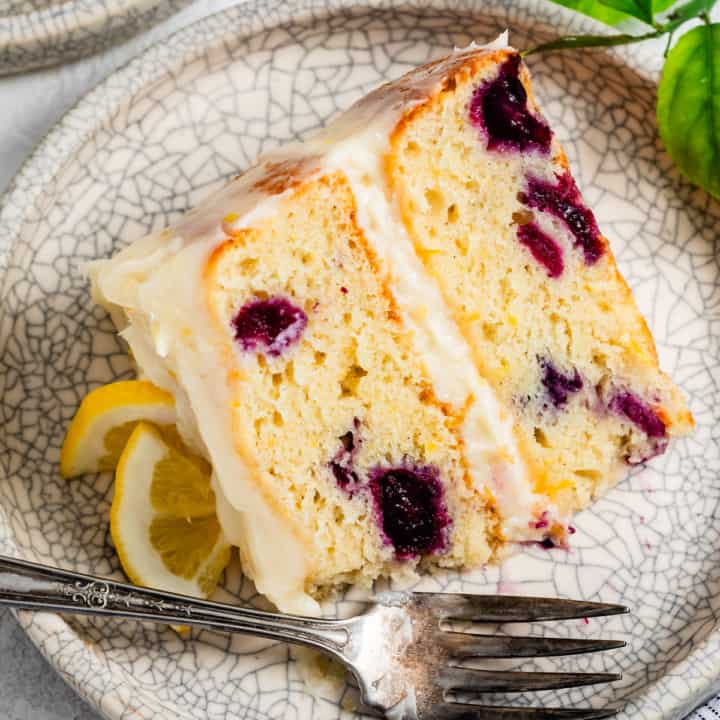



Cheryl Higley -
This cake was exceptionally moist and tender and just full of flavor. Great idea to use coconut extract in both the cake and the frosting and the coconut milk. Adorable for Easter with the Cadbury eggs! I can also imagine serving it with the sides thinly frosted (semi-naked icing) and just the top iced for a rustic baby or bridal shower 3-layer cake.